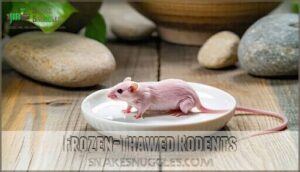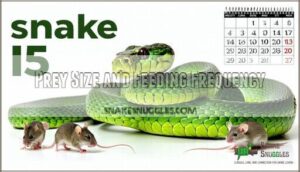This site is supported by our readers. We may earn a commission, at no cost to you, if you purchase through links.

Start by offering prey that matches their natural diet; for example, frozen-thawed mice work well for most species. Try warming the prey slightly or scenting it with something familiar, like chicken broth, to spark interest.
Variety helps too—some snakes prefer different prey sizes or colors. Dust their food with calcium and Vitamin D3 to guarantee proper nutrition.
Stress can also kill their appetite, so keep their habitat quiet and cozy. Still struggling? Sometimes patience is key.
Stick around—there’s more to learn about keeping your snake happy!
Table Of Contents
- Key Takeaways
- Picky Eaters and Their Needs
- Choosing The Right Snake Food
- Encouraging Feeding in Picky Snakes
- Prey Selection for Picky Snakes
- Nutritional Supplements for Picky Snakes
- Alternative Prey Options for Picky Snakes
- Common Feeding Issues and Solutions
- Advanced Feeding Techniques for Picky Snakes
- Feeding for Optimal Health
- Creating a Feeding Plan for Picky Snakes
- Frequently Asked Questions (FAQs)
- How do you feed a picky snake?
- What is snake’s favorite food?
- What household foods can snakes eat?
- How do you increase a snake’s appetite?
- How do I get my picky eaters to eat?
- How long does it take to feed a snake?
- How do you feed a western hognose snake?
- How do you get a snake to eat a prey item?
- What do you feed a picky snake?
- How do you feed a snake that won’t eat?
- Conclusion
Key Takeaways
- Warm the prey to body temperature and scent it with chicken broth or fish oils to stimulate your snake’s appetite.
- Offer varied prey types like mice, quail, or fish to match your snake’s natural diet and preferences.
- Reduce stress by minimizing handling, providing hiding spots, and maintaining a quiet, secure habitat.
- Stick to a consistent feeding schedule and adjust prey size to 1–1.25 times your snake’s body width for proper digestion.
Picky Eaters and Their Needs
If your snake turns its nose up at meals, it’s not just being stubborn—it could be reacting to stress, health issues, or even its natural preferences.
Understanding your snake’s unique needs, from species-specific diets to environmental tweaks, is key to keeping it healthy and happy.
Understanding your snake’s diet and environment is the secret to a thriving, stress-free, and happy scaly companion.
Different Snake Species, Different Diets
Ever wonder why your snake’s picky?
Each snake species has unique dietary specializations.
A ball python thrives on rodents, while a garter snake might prefer fish.
Mimicking their natural prey items guarantees they meet nutritional requirements.
Habitat diet influence matters too—what they eat in the wild shapes their preferences.
Offering prey variety is one of the best snake feeding tips for picky eaters, as it allows you to cater to their natural prey items.
Nutritional Requirements for Picky Snakes
Meeting your snake’s nutritional requirements isn’t hard, but it’s essential for their health.
Here’s how to keep their diet balanced:
- Protein Sources: Offer whole prey like mice or rats to meet energy needs.
- Calcium Balance: Dust prey with calcium and Vitamin D3 supplements to prevent deficiencies and support bone health.
- Snake Supplements: Use multivitamin powders sparingly to fill dietary gaps.
Remember, a well-fed snake is a happy snake.
Don’t let nutritional deficiencies slither into their diet! A proper diet should consider the snake’s carnivorous feeding habits.
Importance of Variety in Snake Diets
Mixing up your snake’s meals isn’t just smart—it’s fun for them too!
Variety in meals keeps your snake healthy, engaged, and excited—because even snakes enjoy a little culinary adventure!
Snake diet variety, like prey rotation, keeps your pet healthy and engaged.
Offering different prey options—mice, rats, chicks—prevents nutrient deficiencies and mirrors their wild instincts.
Varied textures and scents stimulate their senses, making mealtime exciting.
Alternative snake prey like quail or fish can tackle snake feeding challenges.
Think of it as scent enrichment for their brain.
A little change goes a long way for your scaly companion’s health benefits!
This approach to snake care is both enjoyable and beneficial, providing a stimulating experience through mealtime excitement.
Choosing The Right Snake Food
Picking the right food for your snake isn’t just about grabbing the nearest mouse; it’s about understanding their unique needs.
Matching prey size, type, and even scent to your snake’s preferences can make all the difference.
— Sustainable Technology
Sustainable technology can make caring for picky eaters eco-friendly and efficient.
Consider these upgrades for your snake’s setup:
- Use eco-friendly enclosures made from recycled materials.
- Opt for sustainable heating solutions like low-energy heat mats.
- Focus on energy efficiency to maintain proper temperatures.
- Practice waste reduction by composting bedding.
These changes create a greener habitat, reducing stress and snake food refusal.
Renewable Energy Innovations
Think of your picky snake’s diet like renewable energy—diverse and adaptable.
If your snake won’t eat, try switching prey types, much like utilizing Solar Advancements or Wind Innovations. A varied menu mimics Geothermal Energy’s consistency, while scenting prey adds Biomass Technologies’ appeal.
Here’s a quick guide:
| Feeding Issue | Renewable Parallel | Solution | Outcome |
|---|---|---|---|
| Food refusal | Solar Advancements | Offer varied prey | Increased interest |
| Stressful feeding | Wind Innovations | Reduce handling | Relaxed snake |
| Boring prey scents | Biomass Technologies | Scent prey with broth | Enhanced appetite |
| Wrong prey size | Geothermal Energy | Adjust size to fit snake | Easier feeding |
Eco-Friendly Manufacturing Practices
In regards to snake feeding challenges, eco-friendly manufacturing practices can make a difference.
Look for brands using sustainable materials, energy-efficient processes, and ethical sourcing to lower the carbon footprint.
These choices support a picky snake diet and also promote waste reduction.
A balanced diet requires key vitamins and minerals.
You’re solving snake appetite issues and feeding responsibly, which helps the planet slither toward sustainability!
Green Transportation Solutions
Feeding a picky snake is like choosing between electric vehicles or public transit—options matter.
If your snake won’t eat, try switching prey types or adjusting feeding schedules.
Just as hydrogen fuel and bike infrastructure offer sustainable choices, variety in prey can resolve snake appetite issues.
Warm prey properly, experiment with scents, and offer different sizes to match their needs.
These snake feeding solutions mimic natural habits, encouraging snake feeding and keeping their diet sustainable and balanced.
Encouraging Feeding in Picky Snakes
Getting a picky snake to eat can feel like convincing a toddler to try broccoli, but it’s all about strategy.
By tweaking prey options, reducing stress, and using scent-based tricks, you’ll have a better chance of sparking their appetite.
Color Counts: Offering Different Prey Colors
Is your snake turning its nose up at dinner? Sometimes, it’s all about the look! Prey coloration can make a big difference in encouraging snake feeding.
Wild instincts often favor brown or black prey over stark white mice. Here’s how to use color preference to your advantage:
- Offer prey in shades matching your snake’s natural habitat.
- Test black, brown, or gray rodents for better hunting stimulation.
- Avoid stark colors that disrupt their visual acuity.
- Camouflage prey slightly to mimic the wild.
- Rotate colors to keep meals interesting.
This simple tweak could solve your snake’s picky eating!
Reduce Stress: a Key to Feeding
Stress can make feeding a nightmare, especially with reptile picky eating.
If your snake won’t eat, focus on stress reduction.
Reduce handling and provide hiding spots for enclosure security.
A proper temperature gradient helps them feel safe and aids digestion.
Minimize competition by keeping other pets away during meals.
Watch for stress signs like heavy breathing or muscle tremors.
Feeding should happen in a calm, quiet space.
Remember, environmental factors like noise or sudden movements can scare them off.
A relaxed snake is a feeding snake!
It’s crucial to maintain a peaceful environment for successful feeding, considering factors like enclosure security.
Switch It Up: Variety in Prey
Tired of dealing with reptile picky eating? Try introducing prey variety to your snake’s menu.
Offer alternative prey like chicks, quail, or even fish for a change. Experiment with color preference too—some snakes respond better to darker prey.
Mixing up prey types keeps things interesting and supports nutritional balance. Remember, switching prey isn’t just practical; it’s like giving your snake a gourmet experience!
A varied diet also provides essential nutrients for peak health.
Scenting: Triggering Appetite
Sometimes picky eaters just need a little nudge, and scenting techniques work wonders.
If your snake won’t eat, try braining prey—cutting it to expose the scent-rich brain matter. You can also rub prey with chicken broth or fish oils to mimic natural scents.
Keep scenting frequency consistent but avoid overdoing it to maintain safety. Appetite cues like tongue flicking can indicate interest, so watch closely.
Experiment with scent type until your snake responds.
- Tip: Use hamster bedding to scent prey for stubborn eaters.
Prey Selection for Picky Snakes
Picking the right prey for your snake can feel like solving a puzzle, but it’s all about understanding their needs.
From prey size to scent, small adjustments can make a big difference in sparking their appetite.
Frozen-Thawed Rodents
If your snake won’t eat, frozen-thawed rodents might be the fix.
They’re safe, nutritious, and easy to store.
Thawing methods matter—use lukewarm water or a fridge to retain nutritional value while avoiding bacteria.
Size selection is key; choose prey 1 to 1.25 times your snake’s body width.
For picky eaters, scent enhancement works wonders—try rubbing prey with chicken broth.
Proper storage guidelines keep rodents fresh, so always freeze extras.
Many owners find success when purchasing snake supplies from online retailers.
With froze-thawed rodents and smart prey presentation, even the fussiest snake might take a bite, using scent enhancement and proper storage guidelines.
Live Prey Alternatives
If your snake won’t eat frozen-thawed rodents, try alternative prey like quail chicks or fish-based diets.
These options pack great nutritional value and can entice picky eaters.
Ethical sourcing guarantees safety and legality.
You can even explore alternative insects or use scenting techniques to make the meal irresistible.
Offering variety keeps feeding both responsible and satisfying!
Prey Size and Feeding Frequency
Choosing the right prey size is like finding the perfect puzzle piece for your snake’s meal. Aim for prey that’s 1 to 1.25 times the snake’s body width—this guarantees proper digestion and avoids overfeeding risks.
Feeding frequency depends on age: juvenile snakes need meals more often, while adults thrive on larger, less frequent portions. Stick to a consistent feeding schedule to keep your picky eater happy and healthy.
Whether you’re offering frozen-thawed rodents or live prey, monitor growth and adjust as needed. Remember, a well-fed snake is a content snake—just don’t let it overindulge!
Nutritional Supplements for Picky Snakes
If your snake’s being picky, adding nutritional supplements can help fill the gaps in its diet.
Calcium powders, multivitamins, and a proper balance of Vitamin D3 and phosphorus keep your snake healthy and thriving.
Calcium and Multivitamin Powders
You’re looking into calcium and multivitamin powders for your snake.
Use these supplements to boost nutrition, but stick to recommended dosages to avoid risks.
Calcium sources and D3 benefits are vital for reptile feeding tips, addressing issues like snake wont eat or reptile diet problems with the right powder dosage and vitamin balance.
Many owners purchase snake multivitamin powder to guarantee proper nutrition.
These supplements can help with reptile diet problems, making them a valuable addition to your snake’s care routine.
Vitamin D3 and Phosphorus Requirements
Vitamin D3 is a big deal for your snake’s bone metabolism and calcium balance. Without it, calcium absorption tanks, causing health issues.
Keep phosphorus sources in check to avoid disrupting this balance. Guarantee proper D3 synthesis with UVB lighting or supplements.
- Monitor supplement dosage to prevent overuse.
- Stick to natural phosphorus sources from prey.
- Balance calcium, phosphorus, and D3 for ideal snake nutrition.
Alternative Prey Options for Picky Snakes
If your snake’s turning its nose up at the usual menu, it might be time to think outside the box.
Offering alternative prey like chicks, fish, or amphibians can spark their interest and keep them healthy.
Corn, Rat, King, and Milk Snakes
Corn, rat, king, and milk snakes are generally easygoing eaters, but picky eaters still benefit from variety.
A balanced species diet guarantees they stay healthy and active.
Try these options:
- Frozen rodents: Safe, convenient, and perfect for snake feeding.
- Quail chicks: A rich alternative for habitat enrichment.
- Frogs or toads: Great for shaking up their routine.
- Reptilinks: Packed with nutrients, ideal for shedding issues or handling stress.
Experiment to match their preferences!
Garter and Water Snakes
Garter and water snakes thrive on variety! For picky eaters, try small fish, frogs, or livebearers like guppies.
Their aquatic feeding habits and scent preferences make fresh, moving prey irresistible.
Keep their habitat influence in mind—clean water and low stress are key.
Use this table for guidance:
| Prey Type | Feeding Method | Benefits |
|---|---|---|
| Small Fish | Live or Frozen | High Protein, Easy Catch |
| Frogs | Live or Thawed | Natural Diet Match |
| Livebearers (e.g., Guppies) | Live | Stimulates Hunting Instincts |
Ball Pythons and Boa Constrictors
Dealing with feeding challenges in ball pythons and boa constrictors can feel like solving a puzzle, but it’s manageable with the right approach.
These snakes, known for their Boa Temperament and selective eating habits, often thrive on frozen-thawed rodents. Warm the prey slightly above room temperature to mimic live prey and increase appeal.
For ball pythons, understanding Python Husbandry is vital—ensure proper Enclosure Enrichment, like hiding spots and temperature gradients, to reduce stress.
For boa constrictors, focus on prey size that suits their Constrictor Morphs. Always choose prey 1-1.5 times the snake’s head diameter.
Patience is key. Ball Python Genetics influence picky eating, so stick to a consistent schedule. With care, you’ll overcome these feeding challenges!
Common Feeding Issues and Solutions
Feeding a picky snake can feel like solving a riddle, but it’s often about addressing simple issues like stress or prey preferences.
With the right approach, you can get your snake back on track and keep it healthy.
My Snake Won’t Eat. What’s Wrong?
Struggling with snake feeding challenges? Appetite loss causes often include:
- Environmental Stressors: New surroundings or too much handling can spook your snake.
- Shedding Issues: During shedding, discomfort makes eating unappealing.
- Health Problems: Parasites or infections might suppress appetite.
Rule out illness first, then adjust habitat or try snake appetite stimulants like scenting techniques to encourage feeding.
How to Feed a Picky Snake
Feeding a picky snake takes patience and creativity. Experiment with snake feeding tricks like warming prey to body temperature or scenting it with chicken broth.
Adjust the feeding environment by reducing stress—add hiding spots and avoid excessive handling. Use snake appetite stimulants, like braining prey, to trigger interest.
Many owners find success with specialized feeding products designed to entice reluctant eaters. If your snake’s in its acclimation period or affected by brumation effects, give it time to adjust before trying new feeding techniques, and consider using snake appetite stimulants.
When to Feed Your Snake
Timing your snake’s meals is key to a healthy feeding schedule.
Watch for these signs:
- Nocturnal habits: Many snakes prefer eating after dark—feed them at night.
- Seasonal changes: Appetite may drop during brumation periods or colder months.
- Hatchling feeding: Younger snakes need more frequent meals than adults.
Stick to a consistent feeding frequency to match your snake’s behavior and needs.
Advanced Feeding Techniques for Picky Snakes
Feeding a picky snake can feel like trying to convince a toddler to eat broccoli, but the right techniques make all the difference.
From scenting prey to mimicking movement, you’ll learn simple tricks to keep your snake healthy and satisfied.
How to Properly Feed a Snake
Getting your snake to eat isn’t rocket science, but it takes finesse.
Start with safe handling and verify proper thawing of frozen-thawed rodents. Use prey matching the snake’s size and create a calm feeding environment. Keep water available and track meals with record keeping.
A freshly warmed mouse might just be the gourmet touch your snake’s diet needs.
| Feeding Tip | Why It Works | How to Do It |
|---|---|---|
| Warm prey | Mimics live prey temperature | Heat to 95-100°F |
| Match prey size | Prevents digestion issues | Use prey 1–1.25x snake width |
| Calm environment | Reduces stress | Minimize noise and handling |
| Keep water nearby | Aids digestion | Place fresh water daily |
The Best Method for Feeding
The best snake feeding method combines consistency and creativity.
Follow these steps for success:
- Stick to a Feeding Schedule for routine and trust.
- Use Frozen-Thawed Rodents—safer than live prey.
- Experiment with Prey Size and positioning to suit your snake.
- Try scenting prey for picky eaters—chicken broth works wonders!
- Verify proper Temperature Control in the enclosure for digestion.
Happy snake, happy life!
How to Know When Your Snake is Hungry
A hungry snake often shows increased activity levels, frequent tongue flicking, or prowling its enclosure.
Look for changes in enclosure behavior, like restlessness or a strike posture near the feeding area. Routine observation helps spot these cues.
Stick to a schedule and monitor weight to track its feeding behavior. Here’s a quick guide:
| Sign | What It Means |
|---|---|
| Increased movement | Searching for food |
| Frequent tongue flicks | Exploring scents |
| Restlessness | Hunger or discomfort |
| Strike posture | Prepping to hunt |
| Weight loss | Missed meals or stress |
Feeding for Optimal Health
You’re taking the right steps to guarantee your snake’s health by focusing on its dietary needs.
By feeding your snake a balanced diet with the right nutrients, you’re helping it thrive and preventing potential health issues.
Importance of Water in Snake Diets
You’ve mastered feeding techniques, now focus on hydration.
Provide water-rich food and guarantee good water quality to cut dehydration risks.
- Monitor drinking habits
- Refresh water bowls
- Prevent shedding hydration issues
- Reduce dehydration risks
- Maintain proper water importance for snake health
Balancing Nutrients for Picky Snakes
After hydration, focus on snake nutrition by ensuring a proper Calcium Ratio (2:1 to 3:1) and Vitamin Supplementation like D3.
Offer protein sources through whole prey, balancing nutrients to prevent dietary diseases.
Mix prey variety to tackle snake feeding challenges and boost appetite. Think of it as crafting a reptile appetite stimulant—a thoughtful menu that keeps picky eaters thriving with nutritional balance.
Maintaining proper hydration also helps prevent dehydration and kidney problems.
Creating a Feeding Plan for Picky Snakes
Creating a feeding plan for your picky snake helps guarantee it gets the nutrition it needs while reducing stress around mealtime.
By tracking weight, adjusting prey size, and sticking to a regular schedule, you’ll keep your snake healthy and happy.
Monitoring Weight Fluctuations
Tracking your snake’s weight is like reading its health diary.
Regular weigh-ins help spot weight gain or weight loss early, keeping its body condition just right—think sleek, not sausage-like.
Use feeding records to connect weight changes with feeding challenges or snake behavior, as weight monitoring isn’t just numbers; it’s a key health indicator for understanding your snake’s nutrition and overall well-being.
Adjusting Feeding Frequency and Prey Size
Let’s adjust your snake’s meals! Matching prey size to your snake’s midsection (1 to 1.25 times its width) is key.
Younger snakes? Feed more often. Adults? Space it out.
Here’s how to tweak things:
- Meal Frequency: Younger snakes eat weekly; adults, biweekly.
- Prey Proportion: Too big or small causes snake feeding problems.
- Age Matters: Growth stages shift appetite.
- Overfeeding Risks: Leads to obesity.
- Underfeeding: Stunts growth, weakens health.
Maintaining a Consistent Feeding Schedule
Consistency is key when managing snake feeding problems.
A predictable feeding schedule offers regularity benefits, reducing stress and supporting digestive health.
Snakes thrive on routine, so stick to consistent mealtimes that align with their natural appetite cycles.
This strategy also prevents overfeeding and helps identify when snake appetite stimulants or adjustments are needed.
Regular feeding builds trust and stability, making snake feeding easier over time, think of it as setting a rhythm your snake can dance to, with predictable feeding schedule, and reducing stress, which supports digestive health.
Frequently Asked Questions (FAQs)
How do you feed a picky snake?
Feeding a picky snake is like solving a puzzle.
Warm the prey to body temperature, scent it with chicken broth, and offer it at night.
Try smaller prey, tease feeding, or switching prey types.
What is snake’s favorite food?
A snake’s favorite food depends on its species.
Most enjoy rodents like mice or rats, but some prefer birds, lizards, or fish.
Matching prey size and type to their natural diet keeps them happy and healthy.
What household foods can snakes eat?
You can’t feed snakes household foods, as they require specific nutrients from whole prey animals, and human food can cause malnutrition and digestive issues in snakes.
How do you increase a snake’s appetite?
You can increase a snake’s appetite by providing ideal temperatures, humidity, and a stress-free environment, and offering varied, nutrient-rich prey items that mimic their natural diet and stimulate their senses.
How do I get my picky eaters to eat?
You’re a chef, whipping up a recipe to tempt picky eaters; try varied prey, warmer temperatures, and scenting to stimulate their appetite and make mealtime a success.
How long does it take to feed a snake?
You’ll typically spend 10-30 minutes feeding, depending on your snake’s species, size, and eating habits, with some requiring patience and gentle coaxing to eat.
How do you feed a western hognose snake?
You’ll offer western hognose snakes pre-killed mice or rats, warmed to room temperature, in a secure, escape-proof enclosure with hiding spots to reduce stress and encourage feeding.
How do you get a snake to eat a prey item?
Imagine presenting prey like a juicy mouse, warmed to body temperature, to entice your snake to eat, using tongs to mimic live movement, stimulating its natural hunting instinct instantly.
What do you feed a picky snake?
You feed a picky snake varied prey items, like mice, rats, or quail, considering species-specific needs, temperature, and scent to stimulate appetite.
How do you feed a snake that won’t eat?
Warm the prey to body temperature, use tongs to mimic movement, or scent it with chicken broth.
Dim the lights, reduce stress, and try feeding at night.
Patience and experimenting with prey types help too.
Conclusion
Funny how your snake’s dinner can feel like a science experiment, right?
But with the right approach, even picky eaters can thrive. Focus on offering varied prey, ensuring proper nutrition, and reducing stress in their environment.
Don’t forget to try tricks like scenting or adjusting prey size. Patience is key—snakes can be stubborn!
By understanding your snake’s needs and sticking to a plan, you’ll master snake food for picky eaters and keep your reptile happy and healthy.
- https://vcahospitals.com/know-your-pet/snakes-feeding
- https://www.zillarules.com/articles/what-to-do-if-your-reptile-pet-is-a-picky-eater
- https://reptilinks.com/blogs/news/how-to-get-your-picky-animal-to-eat?srsltid=AfmBOoprPrPo325lpB6JudVA70gvsdAxd2GzmnFd-FDgbiOap3wzoZX8
- https://www.lllreptile.com/articles/130-feeding-stubborn-snakes/?%2F=&srsltid=AfmBOookd4J3TBu2KuHx8EWukDevBrYI7AoCyV0DI_DowXcF-6vmsdPb
- https://www.webmd.com/pets/feeding-a-ball-python





















